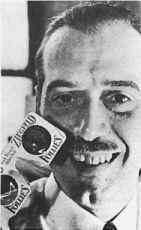Laurens Hammond
| Laurens Hammond | |
|---|---|
|
Hammond with his 3D glasses | |
| Born |
January 11, 1895 Evanston, Illinois |
| Died |
July 3, 1973 (aged 78) Cornwall, Connecticut |
| Education | Cornell University |
| Parent(s) | William Andrew and Idea Louise Strong Hammond |
|
Engineering career | |
| Discipline | Mechanical engineering |
| Projects | Hammond organ, Hammond clock |
Laurens Hammond (January 11, 1895 – July 3, 1973), was an American engineer and inventor. His inventions include, most famously, the Hammond organ, the Hammond Clock, and the world's first polyphonic musical synthesizer, the Novachord.
Youth
Laurens Hammond was born in Evanston, Illinois, to William Andrew and Idea Louise Strong Hammond. Laurens showed his great technical prowess from an early age. His father, William, took his own life in 1898, ostensibly due to the pressures of running the First National Bank, which he had founded. Upon her husband's death, Idea, who was an artist, relocated to France with Laurens to further her studies. It was during their stay in France that Laurens began developing many of his early inventions.
Early inventions
When the family returned to Evanston, Laurens, then 14, was as fluent in French and German as he was in his native tongue. By this time, he had already designed a system for automatic transmission for automobiles. At his mother's suggestion, he submitted his designs to engineers at French automaker Renault, only to be rejected.
University and Military Service
Hammond studied mechanical engineering at Cornell University, and was a member of the Delta Upsilon fraternity. He graduated with honors in 1916. At this time most thoughts were concentrated on the ongoing World War I, and Hammond made his contribution to the war effort, serving with the 16th Regiment Engineers (Railway), American Expeditionary Force, in France.
Inventions
Following this, Hammond moved to Detroit, where he was fortunate to occupy the post of chief engineer for the Gray Motor Company, a manufacturer of marine engines. A partner in the company, Col. John H. Poole, with whom Hammond had served in France, knew of his engineering skills, and paid him an extra $300 a week under the table to stay with Gray Motor. In 1919, Hammond invented a silent spring-driven clock.[1] This invention brought him enough money to leave Gray Motor Company and rent his own space in New York City.
In 1922, Hammond invented the Teleview system of shutter glasses in association with 3-D films. One feature was made for the system, a film called Radio-Mania. Hammond premiered his show at the Selwyn Theatre in New York in December 1922 to critical acclaim, but the cost of installing the expensive machinery in the theater killed the project.
In 1928, Hammond founded the Hammond Clock Company, after designing a synchronous clock motor that was inspired by Henry Warren's Telechrons, but was not self-starting. These clocks were still popular in Britain in the 1960s, because they would not display a false time. (If a transient power failure occurs, a self-starting clock will afterwards restart and display an incorrect time.) The British generating stations also corrected the number of cycles at the end of the day so that Hammond clocks would be accurate. Hammond's clock business ran into difficulties in the early 1930s, and he struggled to save it with a number of other inventions, such as an electric bridge table and, slightly later, his famous organ.
In 1933, he bought a used piano, and proceeded to discard everything apart from the keyboard action. Using the keyboard as a controller, he was able to experiment with various sound-generating methods until he found the best one—the tonewheel generator. The company's assistant treasurer, W. L. Lahey, was the organist at the nearby St. Christopher's Episcopal Church, and Hammond consulted him concerning the quality of the new instrument's sound. Thanks to Hammond's prior manufacturing and engineering experience, the tonewheel generator was extremely well-engineered by the time the organ finally went into production. The number of tonewheel organs still in regular use in the twenty-first century is a testament to the quality of the design and execution of the product.
Hammond filed his patent application on January 19, 1934. At that time, unemployment was a major problem due to the Great Depression, and with this in mind, the Patent Office rushed to grant Hammond's application,[2] with the hope of creating jobs in the area.
He was awarded the Franklin Institute's John Price Wetherill Medal in 1940 for the invention of the Hammond electric organ.
World War II
World War II gave Hammond new areas in which to exhibit his technical skill. He helped design guided missile controls, and was awarded patents for infrared and light-sensing devices for bomb guidance, glide-bomb controls, a camera shutter,[3] and a new type of gyroscope. The glide bomb was the forerunner of today's guided missile.
Retirement
Hammond left his position as president of his company in 1955, to allow himself more time to concentrate on researching and developing new ideas. On February 12, 1960, at the age of sixty-five, he retired. At the time of his retirement in 1960, he held ninety patents. He would be granted another twenty before his death.
Notes
Further reading
The most comprehensive source on Laurens Hammond's life and inventions is the book by Stuyvesant Barry, Hammond as in Organ: The Laurens Hammond Story. This book was never published, but is available on the web at The Hammond Organ Story.
External links
- "Electric Pipeless Organ Has Millions of Tones". Popular Mechanics (April 1936). – one of the first large detailed article on the Hammond Organ and how it worked
- "Hammond Products". OrganHouse.com. – a collection of Hammond products including: clock, organ, Novachord, Solovox, rhythm Machine, and bridge table.
- Blip
